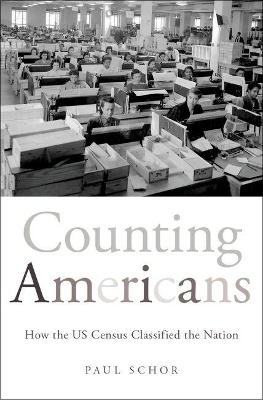
Counting Americans
Oxford University Press Inc (Verlag)
978-0-19-991785-3 (ISBN)
How could the same person be classified by the US census as black in 1900, mulatto in 1910, and white in 1920? The history of categories used by the US census reflects a country whose identity and self-understanding--particularly its social construction of race--is closely tied to the continuous polling on the composition of its population.
By tracing the evolution of the categories the United States used to count and classify its population from 1790 to 1940, Paul Schor shows that, far from being simply a reflection of society or a mere instrument of power, censuses are actually complex negotiations between the state, experts, and the population itself. The census is not an administrative or scientific act, but a political one. Counting Americans is a social history exploring the political stakes that pitted various interests and groups of people against each other as population categories were constantly redefined. Utilizing new archival material from the Census Bureau, this study pays needed attention to the long arc of contested changes in race and census-making. It traces changes in how race mattered in the United States during the era of legal slavery, through its fraught end, and then during (and past) the period of Jim Crow laws, which set different ethnic groups in conflict. And it shows how those developing policies also provided a template for classifying Asian groups and white ethnic immigrants from southern and eastern Europe--and how they continue to influence the newly complicated racial imaginings informing censuses in the second half of the twentieth century and beyond.
Focusing in detail on slaves and their descendants, on racialized groups and on immigrants, and on the troubled imposition of U.S. racial categories upon the populations of newly acquired territories, Counting Americans demonstrates that census-taking in the United States has been at its core a political undertaking shaped by racial ideologies that reflect its violent history of colonization, enslavement, segregation and discrimination.
Paul Schor is an associate professor of history at the Université de Paris.
Acknowledgments
Note on Illustrations and Tables
Note on Terminology
Introduction
Part I: The Origins of the U.S. Census: From Enumeration of Voters and Taxpayers to "Social Statistics," 1790-1840
Chapter 1: The Creation of the Federal Census by the Constitution of the United States: A Political Instrument
Chapter 2: The First Developments of the National Census (1800-1830)
Chapter 3: The Census of 1840: Science, Politics and "Insanity" of Free Blacks
Part II: Slaves, Former Slaves, Blacks, and Mulattoes: Identification of the Individual and the Statistical Segregation of Populations (1850-1865)
Chapter 4: Whether to Name or Count Slaves: The Refusal of Identification
Chapter 5: Color, Race, and Origin of Slaves and Free Persons: "White," "Black," "Mulatto" in the Censuses of 1850 and 1860
Chapter 6: Color and Status of Slaves: Legal Definition and Census Practice
Chapter 7: Census Data for 1850 and 1860 and the Defeat of the South
Part III: The Rise of Immigration and the Racialization of Society: The Adaptation of the Census to the Diversity of the American Population (1850-1900)
Chapter 8: Modernization, Standardization, and Internationalization: From the Censuses of J. C. G. Kennedy (1850 and 1860) to the First Census of Francis A. Walker (1870)
Chapter 9: From Slavery to Liberty: The Future of the Black Race or Racial Mixing as Degeneration
Chapter 10: From "Mulatto" to the "One Drop Rule" (1870-1900)
Chapter 11: The Slow Integration of Indians into U.S. Population Statistics in the Nineteenth Century
Chapter 12: The Chinese and Japanese in the Census: Nationalities That Are Also Races
Chapter 13: Immigration, Nativism, and Statistics (1850-1900)
Part IV: Apogee and Decline of Ethnic Statistics (1900-1940)
Chapter 14: The Disappearance of the "Mulatto" as the End of Inquiry into the Composition of the Black Population of the United States
Chapter 15: The Question of Racial Mixing in the American Possessions: National Norm and Local Resistance
Chapter 16: New Asian Races, New Mixtures, and the "Mexican" Race: Interest in "Minor Races"
Chapter 17: From Statistics by Country of Birth to the System of National Origins
Part V: The Population and the Census: Representation, Negotiation, and Segmentation (1900-1940)
Chapter 18: The Census and African Americans within and outside the Bureau
Chapter 19: Women as Census Workers and as Relays in the Field
Chapter 20: Ethnic Marketing of Population Statistics
Epilogue: The Fortunes of Census Classifications (1940-2000)
Conclusion
Notes
Abbreviations
Sources and Bibliography
Index
| Erscheinungsdatum | 11.07.2017 |
|---|---|
| Verlagsort | New York |
| Sprache | englisch |
| Maße | 236 x 155 mm |
| Gewicht | 640 g |
| Themenwelt | Geschichte ► Allgemeine Geschichte ► Neuzeit (bis 1918) |
| Geisteswissenschaften ► Geschichte ► Regional- / Ländergeschichte | |
| ISBN-10 | 0-19-991785-X / 019991785X |
| ISBN-13 | 978-0-19-991785-3 / 9780199917853 |
| Zustand | Neuware |
| Haben Sie eine Frage zum Produkt? |
aus dem Bereich


